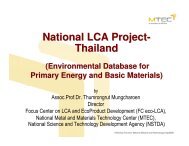ILCD Handbook: Framework and requirements for LCIA models and ...
ILCD Handbook: Framework and requirements for LCIA models and ...
ILCD Handbook: Framework and requirements for LCIA models and ...
Create successful ePaper yourself
Turn your PDF publications into a flip-book with our unique Google optimized e-Paper software.
<strong>ILCD</strong> <strong>H<strong>and</strong>book</strong>: <strong>Framework</strong> <strong>and</strong> <strong>requirements</strong> <strong>for</strong> <strong>LCIA</strong> <strong>models</strong> <strong>and</strong> indicators First edition<br />
For the calculation of endpoint (damage) factors, it is recommended to use the WMO<br />
2003 scenario A1, which predicts that the Equivalent Effective Stratospheric Chlorine (EESC)<br />
concentration will drop in 2044 to below a threshold value (EESC0), when UV damage to<br />
Human Health will equal the natural background. Any ODS emitted after 2040 can be<br />
considered as not contributing to any additional damage.<br />
4.2.1.1 Environmental Mechanism (cause-effect chain)<br />
The picture below illustrates the cause-effect chain used by most <strong>models</strong>. It is similar to<br />
that of the climate model. The link to cataract is becoming more disputed (de Gruijl 2002 <strong>and</strong><br />
Sasaki 1999) <strong>and</strong> the link to immune suppression has not been implemented. NB: this link is<br />
not completely clear.<br />
Wood<br />
production<br />
Effects on ecosystems<br />
<strong>and</strong> productivity<br />
Crop<br />
production<br />
Emissions into the atmosphere<br />
Time integrated concentration of Halons<br />
Decreased ozone concentration<br />
Fish<br />
production<br />
Increased UV-B level<br />
Immune<br />
suppression<br />
Effects on<br />
humans<br />
Midpoint (WMO)<br />
Skin<br />
cancer<br />
Cataract<br />
Figure 4-2 Causality chain of the model to assess impacts of ODS. The link to ecosystems is<br />
generally not modelled in terms of biodiversity losses.<br />
4.2.2 Criteria <strong>for</strong> Evaluation of this impact category<br />
Next to the general criteria described in Chapter 2, the main criteria ‗Environmental<br />
relevance‘ <strong>and</strong> ‗Scientific robustness‘ have been specified by the following sub criteria:<br />
Atmospheric fate <strong>and</strong> transport is considered.<br />
For damages on ecosystems, all relevant effects are considered.<br />
For damages on Human Health, all relevant effects are considered.<br />
All category indicators <strong>and</strong> characterisation <strong>models</strong> linking midpoint to damage fulfil the<br />
science-based <strong>requirements</strong>.<br />
The coverage of the impacts in the modelling from midpoint to endpoint is complete.<br />
The fate <strong>and</strong> transport model reflects the latest state of knowledge.<br />
The human damage model is scientifically robust.<br />
The ecosystem damage model with loss of species is scientifically robust.<br />
4 Requirements <strong>for</strong> specific impact categories 34



